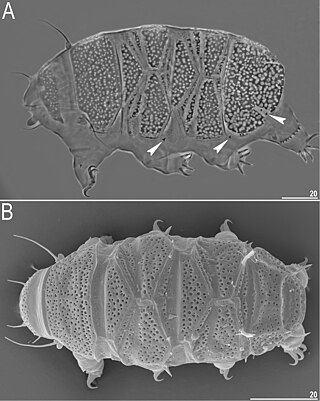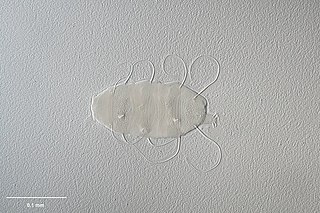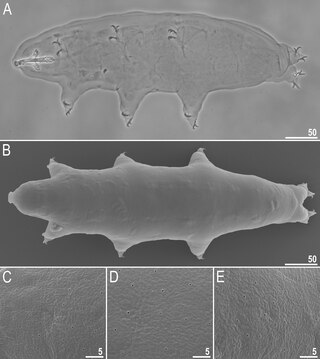
Tardigrades, known colloquially as water bears or moss piglets, are a phylum of eight-legged segmented micro-animals. They were first described by the German zoologist Johann August Ephraim Goeze in 1773, who called them Kleiner Wasserbär'little water bear'. In 1776, the Italian biologist Lazzaro Spallanzani named them Tardigrada, which means 'slow steppers'.

Echiniscus testudo is a cosmopolitan species of tardigrade.

Hypsibius is a genus of tardigrades in the class Eutardigrada.

Isohypsibius is a genus of water bear or moss piglet, a tardigrade in the class Eutardigrada. The length of an isohypsibius tardigrade ranges from 0.1 millimeters to 1.5 millimeters. In addition to eating algae and plant cells, tardigrades also consume insect larvae and even other tardigrades. They live in a lot of places, like damp wooded areas with moss, lichens, leaf litter, and dirt. These animals can also be found in natural lakes and ponds.

Milnesium is a genus of tardigrades. It is rather common, being found in a wide variety of habitats across the world. It has a fossil record extending back to the Cretaceous, the oldest species found so far is known from Turonian stage deposits on the east coast of the United States. Milnesiums are one of the most desiccation and radiation-resistant invertebrates on Earth because of their unique ability to transform into a "tun" state and utilize intrinsically disordered proteins when experiencing extreme environments.
Echiniscoides sigismundi is a species of marine tardigrade. It lives in seaweeds or plates of barnacles, or more generally in algal strongholds in inter-tidal areas.

The Echiniscidae are a family of tardigrades, a phylum of water-dwelling, eight-legged, segmented micro-animals. It is one of the four families in the order Echiniscoidea. The family was named by Gustav Thulin in 1928.

Echiniscus is a genus of tardigrades in the family Echiniscidae. The genus was named and described by Karl August Sigismund Schultze in 1840.
Pseudechiniscus is a genus of tardigrades in the family Echiniscidae. The genus was named and described by Gustav Thulin in 1911.
Parechiniscus is a genus of tardigrades in the family Echiniscidae. It was named and described by Lucien Cuénot in 1926.

Bryodelphax is a genus of tardigrades in the family Echiniscidae. The genus was first described by Gustav Thulin in 1928.
Mopsechiniscus is a genus of terrestrial tardigrades in the family Echiniscidae. It was named and described by Eveline Du Bois-Reymond Marcus in 1944.
Cornechiniscus is a genus of tardigrades in the family Echiniscidae. It was named and described by Walter Maucci and Giuseppe Ramazzotti in 1981.

Antechiniscus is a genus of tardigrade in the family Echiniscidae. The genus was first described by Reinhardt Kristensen in 1987.
Testechiniscus is a genus of tardigrades in the family Echiniscidae. The genus was named and described by Reinhardt Kristensen in 1987.
Proechiniscus hanneae is a species of tardigrade. It is the only species of Proechiniscus, a genus within the family Echiniscidae.
Novechiniscus armadilloides is a species of terrestrial tardigrade. It is the only species of the genus Novechiniscus, which belongs to the family Echiniscidae. The species is endemic to the United States in the state of Utah.

Macrobiotus is a genus of tardigrade consisting of about 100 species.
Pseudechiniscus is a species of tardigrade in the family Echiniscidae. The species is endemic to the island of São Tomé in São Tomé and Príncipe. The species was first described by Paulo Fontoura, Giovanni Pilato and Oscar Lisi in 2010.
Hypechiniscus fengi is a species tardigrade within the family Echiniscidae, described in China by Xizhai Sun and Xiaochen Li. It was compared to other members within its genus, H. exarmatus, H. gladiator, and H. papillifer. Differentiations between the species are; H. fengi having a more robust medium dorsal spine and larger spurs on the internal claws when compared to H. exarmatus; H. fengi lacking a dentate collar on the fourth pair of legs when compared to H. gladiator; and H.fengi lacking papillae on all four pairs of legs when compared to H. papillifer.









